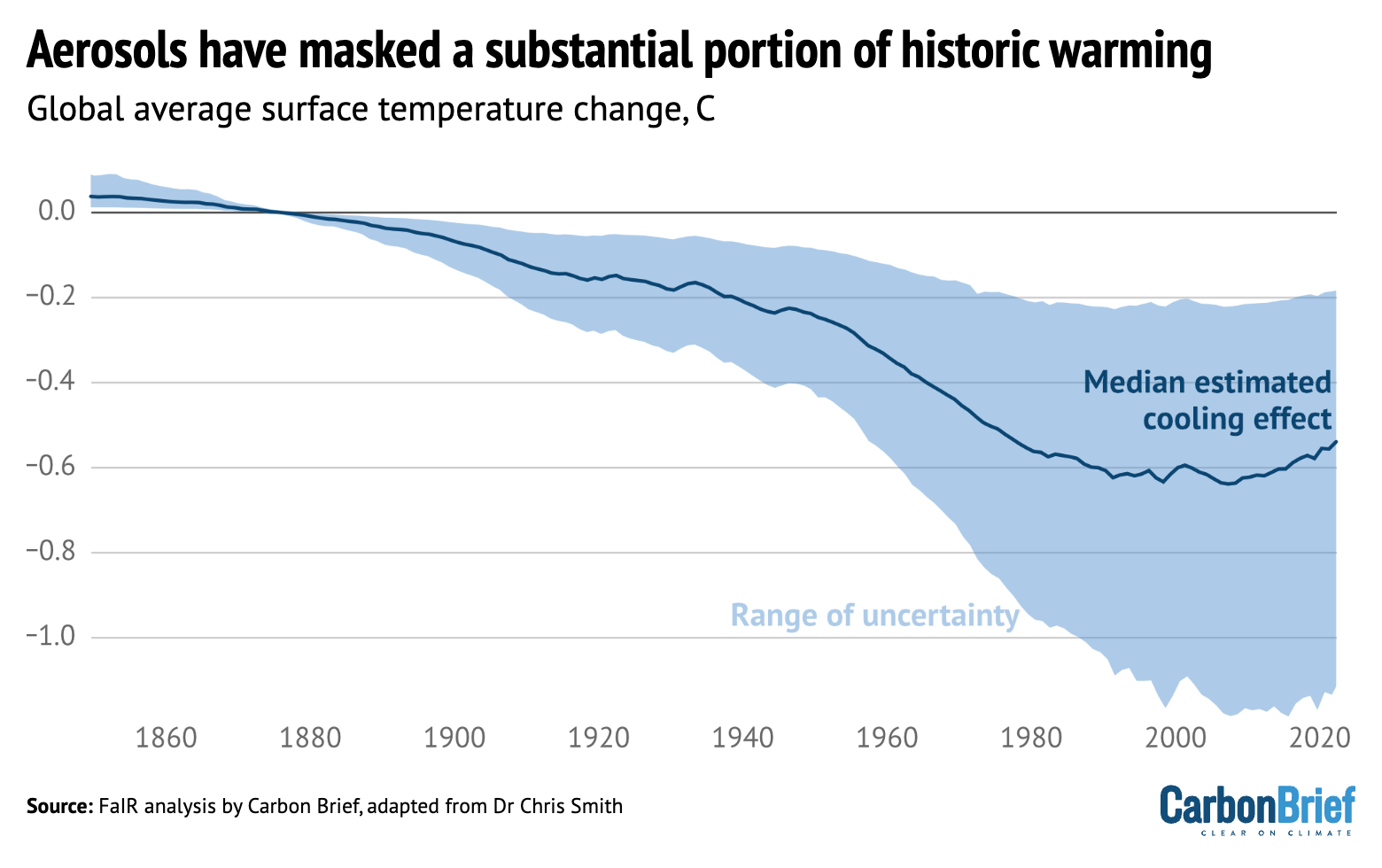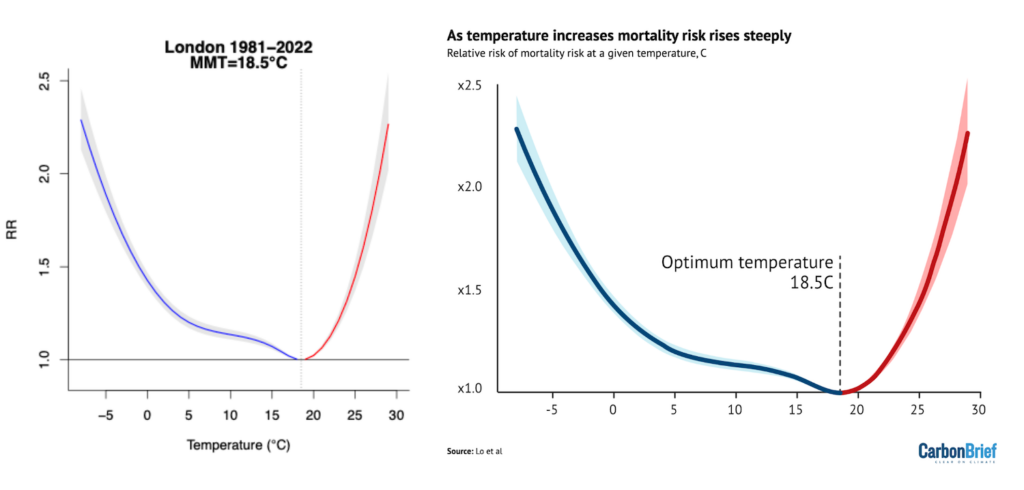Welcome to Carbon Brief’s DeBriefed.
An essential guide to the week’s key developments relating to climate change.
This week
Trump’s latest climate rollback
RULES REPEALED: The US Environmental Protection Agency (EPA) has begun dismantling Biden-era regulations limiting pollution from power plants, including carbon dioxide emissions, reported the Financial Times. Announcing the repeal, climate-sceptic EPA administrator Lee Zeldin labelled efforts to fight climate change a “cult”, according to the New York Times. Politico said that these actions are the “most important EPA regulatory actions of Donald Trump’s second term to date”.
WEBSITE SHUTDOWN: The Guardian reported that the National Oceanic and Atmospheric Administration (NOAA)’s Climate.gov website “will imminently no longer publish new content” after all production staff were fired. Former employees of the agency interviewed by the Guardian believe the cuts were “specifically aimed at restricting public-facing climate information”.
EVS TARGETED: The Los Angeles Times reported that Trump signed legislation on Thursday “seeking to rescind California’s ambitious auto emission standards, including a landmark rule that eventually would have barred sales of new gas-only cars in California by 2035”.
UK goes nuclear
NEW NUCLEAR: In her first spending review, UK chancellor Rachel Reeves announced £14.2bn for the Sizewell C new nuclear power plant in Suffolk, England – the first new state-backed nuclear power station for decades and the first ever under a Labour government, BBC News reported. The government also announced funding for three small nuclear reactors to be built by Rolls-Royce, said the Times. Carbon Brief has just published a chart showing the “rise, fall and rise” of UK nuclear.
MILIBAND REWARDED: The Times described energy secretary Ed Miliband as one of the “biggest winners” from the review. In spite of relentless negative reporting around him from right-leaning publications, his Department of Energy Security and Net Zero (DESNZ) received the largest relative increase in capital spending. Carbon Brief’s summary has more on all the key climate and energy takeaways from the spending review.
Around the world
- UN OCEAN SUMMIT: In France, a “surge in support” brought the number of countries ratifying the High Seas Treaty to just 10 short of the 60 needed for the agreement to become international law, according to Sky News.
- CALLING TRUMP: Brazil’s president Luiz Inácio Lula da Silva said he would “call” Trump to “persuade him” to attend COP30, according to Agence France-Presse. Meanwhile, the Associated Press reported that the country’s environmental agency has fast tracked oil and highway projects that threaten the Amazon.
- GERMAN FOSSIL SURGE: Due to “low” wind levels, electricity generation from renewables in Germany fell by 17% in the first quarter of this year, while generation from fossil-fuel sources increased significantly, according to the Frankfurter Allgemeine Zeitung.
- BATTERY BOOST: The power ministry in India announced 54bn rupees ($631m) in funding to build 30 gigawatt-hours of new battery energy storage systems to “ensure round-the-clock renewable energy capacities”, reported Money Control.
-19.3C
The temperature that one-in-10 London winters could reach in a scenario where a key Atlantic ocean current system “collapses” and global warming continues under “intermediate” emissions, according to new research covered by Carbon Brief.
Latest climate research
- A study in Science Advances found that damage to coral reefs due to climate change will “outpace” reef expansion. It said “severe declines” will take place within 40-80 years, while “large-scale coral reef expansion requires centuries”.
- Climatic Change published research which identified “displacement and violence, caregiving burdens, early marriages of girls, human trafficking and food insecurity” as the main “mental health” stressors exacerbated by climate change for women in lower and middle-income countries.
- The weakening of a major ocean current system has partially offset the drying of the southern Amazon rainforest, research published in Environmental Research has found, demonstrating that climate tipping elements have the potential to moderate each other.
(For more, see Carbon Brief’s in-depth daily summaries of the top climate news stories on Monday, Tuesday, Wednesday, Thursday and Friday.)
Captured

Aerosols – tiny light‑scattering particles produced mainly by burning fossil fuels – absorb or reflect incoming sunlight and influence the formation and brightness of clouds. In this way they have historically “acted as an invisible brake on global warming”. New Carbon Brief analysis by Dr Zeke Hausfather illustrated the extent to which a reduction in aerosol emissions in recent decades, while bringing widespread public health benefits through avoided deaths, has “unmasked” the warming caused by CO2 and other greenhouse gases. The chart above shows the estimated cooling effect of aerosols from the start of the industrial era until 2020.
Spotlight
How Carbon Brief turns complex research into visuals
This week, Carbon Brief’s interactive developer Tom Pearson explains how and why his team creates visuals from research papers.
Carbon Brief’s journalists will often write stories based on new scientific research or policy reports.
These documents will usually contain charts or graphics highlighting something interesting about the story. Sometimes, Carbon Brief’s visuals team will choose to recreate these graphics.
There are many reasons why we choose to spend time and effort doing this, but most often it can be boiled down to some combination of the following things.
Maintaining editorial and visual consistency
We want to, where possible, maintain editorial and visual consistency while matching our graphical and editorial style guides.
In doing this, we are trying to ease our audience’s reading experience. We hope that, by presenting a chart in a way that is consistent with Carbon Brief’s house style, readers will be able to concentrate on the story or the explanation we are trying to communicate and not the way that a chart might have been put together.
Highlighting relevant information
We want to highlight the part of a chart that is most relevant to the story.
Graphics in research papers, especially if they have been designed for a print context, often strive to illustrate many different points with a single figure.
We tend to use charts to answer a single question or provide evidence for a single point.
Paring charts back to their core “message”, removing extraneous elements and framing the chart with a clear editorial title helps with this, as the example below shows.

Ensuring audience understanding
We want to ensure our audience understands the “message” of the chart.
Graphics published in specialist publications, such as scientific journals, might have different expectations regarding a reader’s familiarity with the subject matter and the time they might be expected to spend reading an article.
If we can redraw a chart so that it meets the expectations of a more general audience, we will.
Supporting multiple contexts
We want our graphics to make sense in different contexts.
While we publish our graphics primarily in articles on our website, the nature of the internet means that we cannot guarantee that this is how people will encounter them.
Charts are often shared on social media or copy-pasted into presentations. We want to support these practices by including as much context relevant to understanding within the chart image as possible.
Below illustrates how adding a title and key information can make a chart easier to understand without supporting information.

When we do not recreate charts
When will we not redraw a chart? Most of the time! We are a small team and recreating data graphics requires time, effort, accessible data and often specialist software.
But, despite these constraints, when the conditions are right, the process of redrawing maps and charts allows us to communicate more clearly with our readers, transforming complex research into accessible visual stories.
Watch, read, listen
SPENDING $1BN ON CLIMATE: New Scientist interviewed Greg de Temmerman, former nuclear physicist turned chief science officer at Quadrature Climate Foundation, about the practicalities and ethics of philanthropic climate-science funding.
GENDER HURDLES: Research director Tracy Kajumba has written for Climate Home News about the barriers that women still face in attending and participating in COPs.
OCEAN HEATWAVES: The New York Times presented a richly illustrated look at how marine heatwaves are spreading across the globe and how they affect life in the oceans.
Coming up
- 16-26 June: Bonn climate talks, Bonn, Germany
- 16 June: 79th meeting of the World Meteorological Organization executive council, Geneva, Switzerland
- 17 June: International Energy Agency (IEA) Oil 2025 report launch
Pick of the jobs
- Inside Climate News, California environmental reporter | Salary: Unknown. Location: Southern California
- Natural Resources Wales, lead marine and energy policy advisor | Salary: £45,367-£50,877. Location: Wales
- Children’s Investment Fund Foundation, senior manager, climate | Salary: £82,000. Location: London/hybrid
- Green Party,social media and digital content officer | Salary: £33,211. Location: London/remote
DeBriefed is edited by Daisy Dunne. Please send any tips or feedback to debriefed@carbonbrief.org.
This is an online version of Carbon Brief’s weekly DeBriefed email newsletter. Subscribe for free here.
The post DeBriefed 13 June 2025: Trump’s ‘biggest’ climate rollback; UK goes nuclear; How Carbon Brief visualises research appeared first on Carbon Brief.



